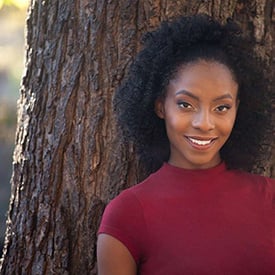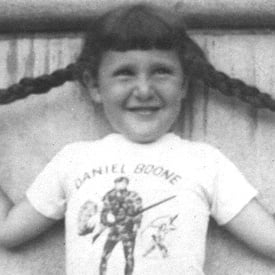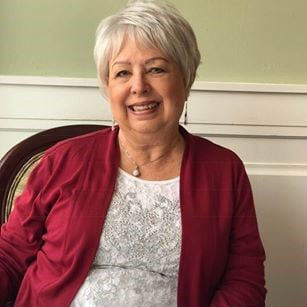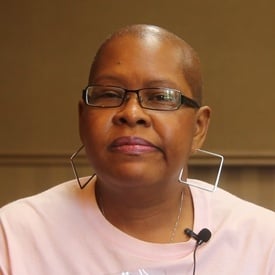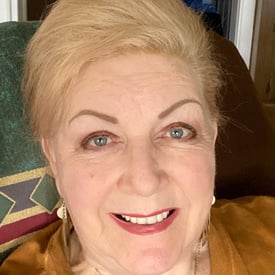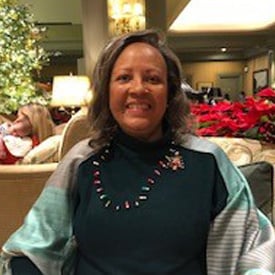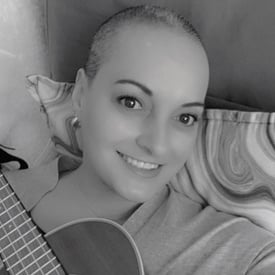Kris W-FFA
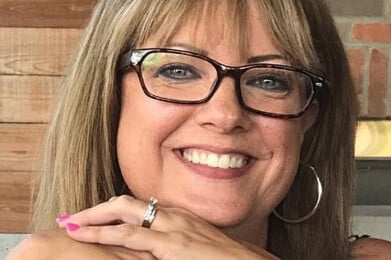
So I googled “FFA” and “alopecia” and was absolutely devastated by what I found…
A Journey with FFA
My journey into hair loss began sometime after 2008, the year I had my hysterectomy at the age of 38. What rid my body of one excruciating problem seemed to kick another one into high gear.
I first noticed changes in my hair in 2013 – the same year I went through an extremely stressful and traumatic work experience. I had always had fine, thin, naturally curly hair but now it seemed to be thinning out and my forehead was getting wider and taller. I figured it was a result of forced menopause – you know, hormonal changes. That and stress. So my hair stylist got creative in how she cut and styled my hair to help camouflage the loss.
I thankfully and gratefully changed jobs which significantly reduced my stress. However, the hair loss continued. I started trying different remedies for hair loss including minoxidil, Nioxxin, Viviscal, and even rubbing essential oils into my scalp. I smelled like an Italian dinner every night when I went to bed! My primary care doctor had me try taking saw palmetto for a few months to see if that helped. I also tried the low level laser helmet for about four months. Thankfully we were able to send that back for a full refund as it, like all the other remedies, didn’t work.
The emotional toll my hair loss took on me was tremendous. Every morning, it became more difficult to tease the hair in different directions to cover the loss. I discovered hair fibers that I could shake on my scalp to help cover the loss. This helped to a degree, but I was always terribly self-conscious that everyone was looking at my scalp. Heaven forbid if it was a windy day! I just knew everyone was then able to see what I had tried so hard to hide. I was also very conscious to not let anyone stand next to me while I was seated for fear they’d see through to my fiber-covered scalp.
My wakeup call came one day in 2016 as I was sitting at a conference table at work looking at the hair lines of the men around the table. I thought, “my god, my hairline looks just like theirs!” I knew then that what was happening to me was NOT normal. I went to the internet to do more research and discovered a physician about two hours away from me who did PRP therapy and hair transplants for hair loss. I contacted him and sent photos of my hair – or lack of it – in all of its fading glory. By looking at the photos alone, he instructed me to go to a dermatologist to get a biopsy for what he suspected was FFA, a term I’d never heard of before. He also told me that neither PRP therapy nor a transplant would work for what he suspected I had.
So I googled “FFA” and “alopecia” and was absolutely devastated by what I found…
Devastated.
Permanent loss of hair.
PERMANENT.
No wonder nothing had worked to fix it. It wasn’t fixable.
I had no control over this.
I will never get my hair back. EVER.
I cried. A lot.
I went to a dermatologist for the biopsy. When I returned two weeks later for the results, the less-than-caring dermatologist coldly announced the results: cicatricial alopecia. Scarring alopecia. In big, bold capital letters across the top of the biopsy results, she wrote “FFA”. She prescribed oral and topical medication and sent me on my way. I got in my car to head to work but I couldn’t start the car as I just sat there for a few minutes and cried. I called my amazing, patient, and loving husband to tell him the results and cried some more. Since I had no symptoms other than the hair loss itself, I never filled the prescriptions as I knew enough from my research that none of these things would bring my hair back. My hair loss was too far progressed to even bother trying to stop it.
Somehow, having this official diagnosis brought a sense of closure to my years of wonder and searching. It actually allowed me to move beyond trying to fix it and move forward with a new acceptance and the desire for a new solution. Perhaps I should just shave my head and embrace a bald me? Maybe I will just wear scarves and hats the rest of my life. They could be my new fashion accessory! Then there is always the wig option. Hmm.
I started exploring these new options. I needed a solution that would allow me to live my life with some semblance of self-confidence. I found a custom hair and wig salon about an hour from me so I thought it couldn’t hurt to go and check that option out. Gracious and kind Sandy listened to my story – one she had heard so many times before – and gave me a big hug. She then introduced me to what was to become my solution for FFA – a bonded hairpiece.
I learned that I could wear a semi-permanent hairpiece that I wouldn’t have to take off every day like a wig (convenient for my lifestyle!). It would be bonded to my scalp with a medical-grade glue and I could sleep in it, swim in it, shower in it and wash and style it nearly like a real head of hair! It would be made of human hair and could be matched to my natural hair color and curl pattern – oh joy of joys! I just had to come in every 4-5 weeks to have it taken off, cleaned, and re-glued to my scalp. I knew it would be an investment financially as my insurance doesn’t cover wigs or hairpieces for alopecia (something I’m currently beginning to advocate for) but I was eager to at least give this option a try. Sign me up!
I had to wait twelve long weeks for the piece to come in! AHH! Now what?
I made the decision to be open with my family, my boss and closest co-workers about my FFA. I was met with gracious and kind understanding and support. For those twelve weeks, I began to wear headscarves every day and actually found them to be comforting. I no longer had to work so darn hard to hide my hair loss! It was actually a great big relief.
The day finally came for me to get my new hairpiece. I was fraught with nervous anticipation yet looked forward to seeing hair on my head again. What was left of my own hair – some on the sides and in the back – I honestly felt like Bozo the clown – was cleaned and the sparse, thin hair on the top of my head was shaved down to accommodate the new custom hairpiece. The piece was glued into place and when they turned my chair around to face the mirror, I started to cry. My initial thought was “I look ten years younger!” and I just marveled at how beautiful the hair was. The stylist cut it into a shape and style similar to how I used to wear it and gave me instructions on how to care for it.
I must tell you that initially, “getting” hair was just as traumatic as losing it. When I went home that day, it just didn’t “look” like me. It was too much hair! I ended up crying – sobbing – in our bathroom in the middle of the night, saying “just take it off! I’ll wear scarves the rest of my life!” I didn’t want to leave the house – I didn’t want anyone to see me with this heavy head of hair. I felt like I had made a costly mistake. I sent pictures of the new hair to my former hair stylist and she had me come in to her salon on a Sunday so she could thin it out and style it more closely to how I used to before the hair loss occurred. I was greatly relieved with this cut and style and, well, began to live life.
It took some time to get used to wearing hair. But I also started to get compliments on my hair – WAY more than I ever did my entire life with my “real” hair! Go figure. Talk about a confidence booster! From then on, my journey with hair loss has mellowed into acceptance of my disease, an ease of talking openly about this rare alopecia called FFA, and a desire to help other women find caring help and resources for their cicatricial alopecia journey.
Permanent hair loss is devastating and a grieving process is necessary for anyone who finds themselves recently diagnosed. However, know you are not alone. There are women all over the globe who understand what you are going through. There is healing in our common bond and there is hope that you can live with this disease in a way that works best for you. I urge you to take advantage of the resources on this website and reach out for help.
With deepest understanding – and a big hug to comfort you,
Kris

